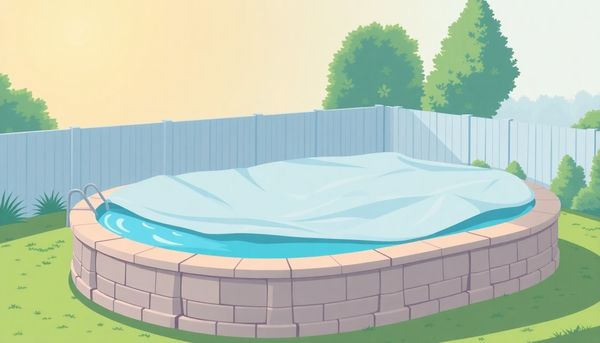Prevent Pool Cover Sagging: Essential Tips for Maintenance
July 27th, 2024
July 27th, 2024
Owning a pool can be one of life’s great pleasures, offering a refreshing escape during sizzling summer days and serving as a picturesque backdrop for gatherings. However, maintaining this aquatic oasis requires more than just skimming the surface or balancing chemicals. One often overlooked aspect is the pool cover, a crucial component in safeguarding your pool from debris, evaporation, and unforeseen weather changes. Yet, many pool owners face a common problem: the dreaded sagging pool cover.
Having dealt with a sagging pool cover myself, I quickly learned this isn't merely an aesthetic issue. A sagging cover can accumulate water and debris, leading to potential damage or even tearing, which defeats its very purpose. To avoid these pitfalls, it's essential to understand why a pool cover might sag in the first place. Factors such as improper installation, inadequate tension, or lack of support can all contribute to this problem.
Furthermore, with the right tools and techniques, maintaining a taut and secure pool cover is entirely achievable. From DIY solutions to professional advice, there are numerous strategies available to tackle this issue head-on. With just a bit of attention and regular maintenance, you can ensure your pool cover remains in tip-top shape, extending its lifespan and keeping your pool pristine and ready for your next plunge.

Rainwater turning your pool cover into a small lake is far from ideal. A pool pump can be your secret weapon in keeping that cover snug and dry. When I first spotted an electric pump at a pool supply store, I was skeptical. But after a few heavy downpours, my skepticism turned into sheer gratitude.
With an electric pump, particularly an automatic submersible one, you can keep your pool cover blissfully free from water accumulation. These devices, designed for inground pools, work tirelessly to siphon off unwanted water. They operate like a charm, with some capable of removing up to 2,450 gallons per hour. Imagine not having to check the pool every time it rains, knowing that the pump will take care of it. The convenience it offers is worth every penny, though I understand it might be a pricey option for some.
For those navigating a tighter budget, manual pumps are a solid alternative. They require a bit more elbow grease but still effectively prevent sagging by removing excess water. If your pool cover is more on the tarp side, a specialized pool cover pump will do the trick. Lightweight and easy to handle, these pumps are perfect for ensuring your above-ground pool cover remains taut and tear-free.
A dependable pump not only extends the life of your pool cover but also saves you countless hours and headaches. Trust me, once you try it, you’ll wonder how you ever managed without it.
Choosing the right pump for your pool cover is akin to picking the perfect tool for a specific task. It can make all the difference between a cover that sags or stays taut, protecting your pool through the harshest winters. Depending on the type of pool and cover you own, the choice of pump can vary significantly.
For owners of inground pools with safety covers, an automatic submersible pump can work wonders. These pumps spring into action without any prompting, efficiently clearing water from the cover. They are designed to handle large volumes at a rapid pace, which means you spend less time worrying about standing water and more time enjoying your free hours. Although they come with a higher price tag, the convenience they offer is unmatched.
If your pool is cloaked with a tarp cover, a specialized pool cover pump is a smart investment. Lightweight yet effective, these pumps cater specifically to the needs of above-ground pool covers, offering a practical solution to water accumulation.
For those looking to save some cash, a manual pump or even a siphon can suffice, especially for above-ground pools. The simplicity of a siphon, which requires no electricity, can appeal to those who appreciate eco-friendly methods. However, these options demand more hands-on involvement, which can be a drawback if time is of the essence.
Choosing wisely not only preserves your pool cover but also brings peace of mind, knowing that your cover can withstand whatever nature throws its way.
Guarding your pool cover is akin to protecting a long-term investment. Attention to detail now can save you from the hassle of replacing it prematurely. Begin with proper installation; ensure the cover is taut and well-fitted, as a saggy cover invites trouble. Secure it with a reliable cable and winch system or use water bags for in-ground tarps, which helps anchor the cover against gusty winds.
Regular maintenance is crucial. After a storm or heavy snowfall, take the time to clear off accumulated debris and water. Pool cover pumps, whether automatic or manual, are your allies here. I recall a blustery winter when I neglected this step, and the weight of the snow nearly dragged my cover into the water. Lesson learned; now, I never let water sit for too long.
Additionally, consider investing in a leaf net. It’s a simple overlay that catches falling leaves before they wet and weigh down your pool cover. Just remove the net, shake it out, and lay it back again. It’s like giving your cover an extra shield against nature’s barrage.
Lastly, periodic inspection for wear and tear is essential. Check seams, straps, and grommets for any signs of weakness. Addressing minor issues promptly can prevent bigger problems from developing. Remember, a little vigilance goes a long way in keeping your pool cover robust and sag-free.
In the quest to defeat a sagging pool cover, the simplest yet most effective weapon is ensuring it is correctly secured and maintained. Start by choosing the right fit—whether it's a durable tarp for above-ground pools or a robust safety cover for inground ones. Whatever your choice, ensuring that all the fastenings are tight is crucial. This means checking straps, cables, and winches regularly to avoid unexpected loosening, which could invite unwanted sag.
Once security is established, maintenance becomes the knight in shining armor. Regular checks, particularly after heavy rain or snow, can save your cover from unnecessary strain. If water accumulation is a problem, investing in a reliable cover pump as mentioned earlier, is a savvy move. This ensures that water, which may weigh down the cover, is swiftly removed, preventing sag and damage.
Moreover, consider using a pool air pillow beneath the cover. This simple addition can significantly reduce the stress on the material by distributing the weight of accumulated water or debris evenly. Remember, though, it's not just about putting the pillow in place; alignment and periodic adjustments ensure even better performance.
Lastly, never underestimate the power of a good clean. Dusting off leaves and other debris with a soft broom can extend the life of your cover. By intertwining proper security and diligent maintenance, you're crafting a saga of a well-protected pool, defying sag and standing strong through the seasons.

Many pool owners know the frustration of sagging covers, particularly during the leaf-laden autumn months. One effective solution lies in the simplicity of a leaf net. A leaf net acts like a protective shield, catching leaves and debris before they can weigh down your pool cover. This not only keeps your cover in optimal condition but also reduces the amount of cleanup needed when the seasons change.
The installation process is straightforward. First, ensure your pool cover is securely fastened and free of water. Then, carefully lay the leaf net over the cover, allowing its edges to extend beyond the pool's perimeter. This overlap is crucial; it ensures leaves don’t slip underneath, negating the net's purpose. Most leaf nets are made from durable polyethylene, designed to withstand harsh weather conditions, ensuring they won’t rip or tear easily under the weight of falling foliage.
From personal experience, removing a well-used leaf net after a blustery fall day is incredibly satisfying. With a gentle shake, leaves are effortlessly discarded, leaving the pool cover underneath pristine and undisturbed. Unlike other methods, a leaf net requires minimal maintenance—simply check regularly and empty as needed. This ensures your pool cover stays free from excess weight, maintaining its tautness, and saving you from costly repairs or replacements. With such a straightforward addition, your pool cover can easily withstand the seasonal onslaught of falling leaves.
Choosing the right pool cover is akin to selecting the perfect outfit for a winter escapade. It needs to be functional, durable, and tailored to your unique pool environment. Consider my friend Jake, who bought a flimsy cover for his above-ground pool, only to find it torn and ineffective after the first gust of wind. Learning from his mistake, he switched to a heavy-duty cover with reinforced grommets. This small upgrade made all the difference, as it stayed secure even during the harshest storms.
When selecting a cover, one size does not fit all. For inground pools, a safety cover with taut straps offers maximum protection, preventing debris accumulation and potential accidents. These covers often come in mesh or solid varieties, each with its own set of advantages. Mesh covers are great for allowing water to drain, while solid ones keep everything out. On the other hand, a tarp cover for above-ground pools demands a cable and winch system for optimal security. Supplement this with clips to fortify its hold against winter winds.
Moreover, investing in a leaf net can be a game-changer. This added layer catches fallen leaves before they pile up, saving you from the hassle of a heavy cleanup. In essence, the right pool cover not only shields your pool from the elements but also streamlines maintenance, ensuring you can enjoy a seamless transition into the swimming season.
Much like a trusty lifeline in a storm, installing a submersible pump can be the saving grace for your sagging pool cover. A good friend once swore by this method after a particularly relentless season of rainwater pooling on his cover, and it quickly became his go-to solution.
There's something deeply satisfying about knowing you can simply set it and forget it. An automatic submersible pump is designed to sit quietly beneath the water, springing into action when the water level rises. One popular choice among pool enthusiasts is the high-efficiency version, boasting a robust 1/3HP power motor capable of moving up to 2,450 gallons per hour. This beast tackles the daunting task of draining with remarkable efficiency, lifting water as high as 28 feet at a time.
For those on a tighter budget, manual pumps also serve as a viable option. While they might require a bit more attention, they're lighter on the wallet and still effective in keeping your pool cover free from unnecessary weight and sagging.
Whichever path you choose, a submersible pump is like that quiet helper who makes sure the job gets done while you’re not looking. It’s an investment in peace of mind, protecting your pool cover from the elements and extending its life by keeping it dry and sag-free, even in the most unpredictable weather.
Securing a pool cover might seem straightforward, but it's an art that requires attention to detail. A snug, well-fastened cover is your best defense against sagging and the potential chaos of winter storms. When I first tackled this task, I underestimated the importance of getting it right, only to find my cover flapping in the wind a few weeks later.
Begin by ensuring that your cover is the correct size for your pool, as an ill-fitting cover is prone to sagging. For an above-ground pool, invest in a quality winter cover that includes a cable and winch system. This duo allows you to snugly fasten the cover, looping the cable through the grommets and ratcheting it tightly. I once tried to cut corners by using an old tarp without grommets; trust me, it's not worth the hassle.
For inground pools, especially those with tarp-style covers, water tubes or bags placed strategically around the edges are a must. These act as anchors, holding the cover in place against the onslaught of wind. Think of them as sandbags during a flood—they prevent chaos. Avoid using heavy objects like bricks, as they can create more problems than they solve if the cover lifts.
Finally, consider adding a bit of water on top of the cover. Just a few inches can help hold it down, provided you monitor it carefully to prevent overloading. By securing your cover properly, you're not just protecting it from sagging; you're preserving the integrity of your pool all winter long.

In the realm of pool cover maintenance, water bags serve as unsung heroes, quietly ensuring everything stays in place. Unlike heavy objects like bricks, which can transform into dangerous missiles if the wind picks up, water bags offer a safe and effective solution. They’re designed to hold your pool cover snugly against the edges, preventing it from taking flight or sagging under the weight of rain and snow.
Remember last winter, when a neighbor's pool cover ended up in someone else's yard after a particularly blustery night? That’s precisely the kind of situation water bags are built to avoid. Made from durable vinyl, these bags can be filled with water and placed strategically around your pool’s perimeter. This creates an even distribution of weight, holding your cover firmly down without damaging the pool or cover itself.
To use them effectively, ensure each bag is filled adequately—no half-measures here. If your pool is larger, you'll need more bags to maintain even tension across the cover. You might think of water bags as your pool cover’s personal bodyguards, ready to fend off unruly weather while you relax indoors. By investing a bit of time to set them up correctly, you not only extend the life of your cover but also enjoy peace of mind knowing your pool is well-protected throughout the off-season.
Keeping a pool cover taut and sag-free isn't just about aesthetics; it's essential for long-term maintenance. One of the most effective ways to combat cover sagging is by implementing strategic water-pump solutions. When chilly spells roll in and rainwater or melting snow accumulates, your pool cover can become a gravity-defying basin. Enter the trusty submersible pump, your new best friend for swift water removal.
Automatic submersible pumps are a boon for inground pools. Imagine a device that tirelessly works to keep your cover water-free without constant supervision. With a high-efficiency motor that can handle thousands of gallons per hour, these pumps are designed for those who value both time and peace of mind. Their robust construction ensures they can lift water from significant depths, making them perfect allies during the stormier seasons.
However, not everyone is inclined to invest in such high-end equipment. No worries, the manual pump is a fair contender. For those on a budget, a manual pump provides a hands-on approach to managing water accumulation. They might require a bit more elbow grease but are reliable and straightforward.
For above-ground pool owners with tarp covers, a specialized lightweight pool cover pump is a game-changer. Built specifically for these covers, they make draining a breeze with easy-to-clean features and hose connections. And if all else fails, the humble siphon stands ready. With minimal cost and no electricity needed, it leverages the power of gravity to clear excess water.
Remember, a well-maintained pool cover saves you a world of hassle and prolongs the life of your pool. Whether you go automatic, manual, or somewhere in between, setting up an effective water-pump solution ensures your cover remains sag-free throughout the colder months.
You’re sitting comfortably in your backyard when you notice your pool cover drooping in the middle, threatening to become a murky water basin. This scenario can be avoided with cost-effective siphon techniques, an affordable and efficient method to keep your pool cover taut.
Using a siphon is a simple, budget-friendly option that relies on gravity to do the heavy lifting. This technique involves using a basic garden hose or PVC pipe to create a siphon that naturally drains water from the pool cover. For those unsure about the DIY approach, investing in an inexpensive, specially designed pool cover siphon can ease the process significantly. These devices, available for a modest cost, come with user-friendly mechanisms. Often equipped with a hand pump or a squeeze bulb, they start the siphoning process without requiring electricity.
My neighbor swears by the pool cover siphon he purchased last year. A few squeezes, and the water is flowing away effortlessly, leaving his cover dry and secure. This method is especially effective for above ground pools, where the elevation difference enhances the draining capability.
While siphoning might not be as fast as an electric pump, it’s a sustainable and silent hero in the battle against sagging covers. Plus, the lack of an electrical component means one less gadget to worry about during the off-season. Embrace this eco-friendly solution and enjoy a sag-free pool cover without straining your budget.
Fallen leaves and random debris may seem harmless, but over time, they can become the unexpected nemeses of your pool cover. Each autumn, as trees shed their leaves, they find their way onto your pool cover, adding unnecessary weight and causing sagging. One effective way to combat this accumulation is by using a leaf net designed to sit atop the pool cover. This lightweight, yet sturdy net acts like a protective shield, capturing leaves and debris before they burden your pool cover. Simply lift, shake off the debris, and place the net back for continuous protection.
For those who prefer tech-savvy solutions, a leaf blower is your best friend. With a quick burst of air, it can clear dry leaves effortlessly. However, ensure the cover is dry before using this method. If the cover is wet or if leaves are damp, a soft broom or skimmer net comes in handy. Carefully sweep the cover, but handle it gently to avoid any damage.
A personal tip from years of owning a pool: never underestimate the power of routine. Regularly cleaning your cover, especially after a windy day, can prevent leaf build-up and extend its lifespan. By maintaining a strict leaf and debris management routine, not only can you prevent your pool cover from sagging, but you also enhance its durability, saving you money and effort in the long run.

The concept of using a pool pillow, or ice compensator, might not be at the forefront of every pool owner's mind. Yet, it's an unsung hero when it comes to preventing that dreaded pool cover sag. Acting as a cushioning force beneath your winter pool cover, the pool pillow serves a dual purpose. Not only does it help prevent water and snow from accumulating in the center of the cover, but it also protects the pool structure itself from the pressure of ice expansion during the colder months.
In the winter, when water freezes and expands, it can exert significant pressure on pool walls. Without a buffer, this can lead to severe structural damage, potentially turning your pool into an expensive water feature. The pool pillow absorbs this expansion, safeguarding the pool walls and maintaining the integrity of the cover. My own experience with a pool pillow transformed winter pool maintenance. I recall a particularly harsh winter where, had it not been for this clever device, the aftermath could have been disastrous.
Positioning the pillow involves some strategy. While it's often suggested to place it centrally, it can work effectively from any spot under the cover. To secure it, consider using a Pool Pillow Pal, which simplifies the process with adhesive patches that keep it in place. This small, often overlooked accessory can prolong the life of both your pool and its cover, saving you on costly repairs and replacements.
Selecting the perfect pump for your pool cover is a vital step in maintaining its integrity throughout the season. Think of the pump as the unsung hero of your pool setup; it silently safeguards your cover from the burden of excess water and debris. For inground pools with safety covers, an automatic submersible pump can be a game-changer. These machines, equipped with robust motors, can efficiently discharge thousands of gallons per hour, keeping your cover clear even when you're not around to supervise. While their upfront cost might seem daunting, the time and hassle they save make them a worthy investment.
On the other hand, if you're managing a tighter budget, a manual approach might suit you better. Manual pumps, though requiring more effort on your part, offer a pocket-friendly alternative. They're particularly effective for smaller pools where water accumulation isn't as severe.
For those with tarp covers, the choice leans towards lightweight, specialized pool cover pumps. Designed specifically for tarps, these pumps quickly remove standing water, preventing the dreaded sagging that can occur when water and debris pool in one spot. Additionally, keep in mind the gravity advantage for above-ground pools: a simple siphon can work wonders. By employing a short garden hose, you can create a natural flow that removes water without any electricity, making it an eco-friendly option. Whatever your choice, the right pump ensures your pool cover stays taut and functional, extending its lifespan significantly.
Sometimes, the key to a well-maintained pool cover lies not above, but below. Introducing the pool air pillow, a simple yet ingenious tool that can save your pool cover from winter woes. This inflatable cushion isn’t just a fancy accessory—it's a strategic addition to your pool cover setup, particularly for those with above-ground pools.
Unlike the myriad gadgets and gizmos one might find in a pool maintenance kit, the air pillow serves a dual purpose. Firstly, it helps to evenly distribute the weight of snow and rainwater, preventing the dreaded cover sag. Accumulation of water and debris in one spot can strain your cover, potentially causing it to rip. By placing an air pillow under the cover, you create a peak that encourages water to run off towards the edges rather than pooling in the center.
Moreover, air pillows act as ice compensators. When the water in your pool freezes and expands, the pillow absorbs this pressure, reducing the risk of damage to the pool walls. It's like having a shock absorber for your pool, keeping everything intact even in the harshest conditions.
Positioning the pillow is straightforward. You don’t need to fuss over its exact placement—just ensure it’s adequately inflated and secured. Some pool owners swear by the Pool Pillow Pal, a nifty tool that anchors the pillow in place without ropes.
Incorporating a pool air pillow into your winter prep routine can be a game-changer, ensuring your cover not only survives the season but thrives through it.
Ensuring a snug and secure fit for your pool cover can mean the difference between a protected oasis and a soggy, debris-ridden mess. By taking a few extra precautions, you can safeguard your cover from sagging and extend its lifespan significantly.
Firstly, consider using a winch system with a durable cable for above-ground pools. This system works wonders by keeping the cover taut and resistant to wind flapping. When winter howls, your cover remains cinched tight, reducing the chance of costly tears or misalignments. A friend of mine swears by adding plastic clips for extra security; they’re cheap and effective, snapping on just under the pool rail to hold everything in place.
For those with inground pools, water bags or Aqua Blocks are your allies. Strategically placed around the pool's edge, these weights keep the tarp steady, preventing it from ballooning in strong gusts. Avoid the temptation of using heavy objects like bricks, as a sudden wind can turn them into dangerous projectiles.
Meanwhile, a layer of water—about one to three inches—on top of the cover is a clever hack to thwart the wind. This weight steadies the cover, acting as a natural windbreak. Remember, though, to regularly pump out excess water to avoid overloading the cover, which could lead to sagging or worse.
Ultimately, these strategies form a robust defense line, ensuring your pool cover remains steadfast against winter’s challenges. By investing a bit of time and effort upfront, you’ll save yourself the headache of frequent replacements or repairs.

Securing a pool cover can feel like wrangling a stubborn kite, especially when the wind picks up. The trick to keeping your cover snug and sag-free lies in mastering the art of strap tightening. Each strap is like a guardian, protecting your pool from the elements, so giving them the attention they deserve is essential.
First, inspect the straps for signs of wear. A fraying strap is a weak link in your pool's armor. Replace any damaged straps to ensure a uniform hold. Next, position the straps evenly across the cover. This balanced tension distributes weight and reduces the risk of sagging. When tightening, start at one end of the pool and work your way to the other. This method ensures a consistent tautness across the cover.
In my experience, the right tools make a world of difference. I once struggled with a particularly stubborn strap until I discovered the convenience of a ratchet strap tensioner. This nifty gadget can turn a daunting task into a quick and satisfying job. When you've achieved the right tension, each strap should feel firm to the touch but not overstrained—too tight, and you risk tearing the cover.
Remember, a well-secured cover is your pool's first line of defense against winter woes. By paying attention to the details of strap-tightening, you're not just maintaining a cover—you're safeguarding a summer of fun.
A pool cover’s worst enemy is water accumulation, and leveraging the right pump solutions can be a game-changer in preventing sagging. While tackling this issue might seem tedious, a high-efficiency submersible pump can lighten the load. With a robust 1/3HP motor, such a pump discharges up to 2,450 gallons per hour and can lift water up to 28 feet, making it indispensable for inground pool owners. This automatic marvel keeps your cover pristine and free from excess water, even when you’re miles away.
However, not everyone wishes to invest heavily in automation. For the budget-conscious or those with a small pool, a manual pump proves to be a worthy ally. These devices may lack the bells and whistles of their electric counterparts, but they offer a straightforward, muscle-powered approach to water removal. Simply attach a garden hose, and with a bit of elbow grease, you can efficiently manage water levels on your pool cover.
For above-ground pools, a siphon pump serves as an innovative and eco-friendly alternative. By employing gravity, a siphon can draw water off your cover without electricity, requiring just a simple squeeze to kickstart the flow. These pumps are perfect for those who prefer sustainable solutions or live in areas where power outages are common. Whether you opt for a high-tech or hands-on approach, choosing the right pump can safeguard your pool cover against winter’s worst.

This article provided insights into maintaining your pool. Start your pool care journey today!
Want to become a pool maintenance expert? Our free Pool School course covers everything you need to know about pool care. From basic maintenance to advanced troubleshooting, you'll learn how to:
Join over 10,000 pool owners who have already transformed their pool care routine. Get started with our free Pool School course today!